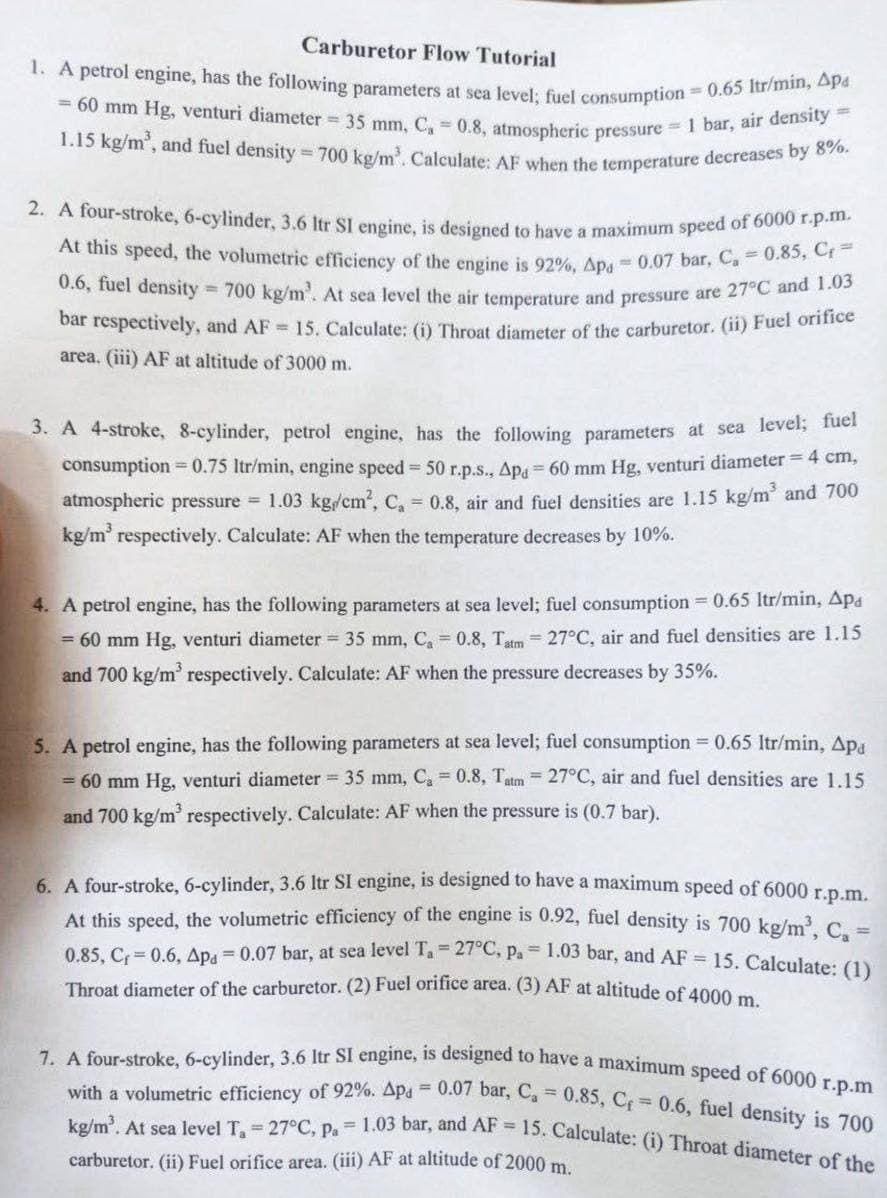1. A petrol engine, has the following parameters at sea level; fuel consumption 0.65 Itr/min, Apa = 60 mm Hg, venturi diameter = 35 mm, C, 0.8, atmospheric pressure = 1 bar, air density 1.15 kg/m, and fuel density =700 kg/m'. Calculate: AF when the temperature decreases by 8%. Flow Tutorial %3D %3D
1. A petrol engine, has the following parameters at sea level; fuel consumption 0.65 Itr/min, Apa = 60 mm Hg, venturi diameter = 35 mm, C, 0.8, atmospheric pressure = 1 bar, air density 1.15 kg/m, and fuel density =700 kg/m'. Calculate: AF when the temperature decreases by 8%. Flow Tutorial %3D %3D
Elements Of Electromagnetics
7th Edition
ISBN:9780190698614
Author:Sadiku, Matthew N. O.
Publisher:Sadiku, Matthew N. O.
ChapterMA: Math Assessment
Section: Chapter Questions
Problem 1.1MA
Related questions
Question

Transcribed Image Text:0.6, fuel density = 700 kg/m'. At sea level the air temperature and pressure are 27°C and 1.03
= 60 mm Hg, venturi diameter = 35 mm, C, = 0.8, atmospheric pressure = 1 bar, air density =
1.15 kg/m', and fuel density =700 kg/m. Calculate: AF when the temperature decreases by 8%.
2. A four-stroke, 6-cylinder, 3.6 Itr SI engine, is designed to have a maximum speed of 6000 r.p.m.
1. A petrol engine, has the following parameters at sea level; fuel consumption 0.65 Itr/min, Apa
7. A four-stroke, 6-cylinder, 3.6 Itr SI engine, is designed to have a maximum speed of 6000 r.p.m
with a volumetric efficiency of 92%. Apa = 0.07 bar, C, 0.85, Cf 0.6, fuel density is 700
kg/m. At sea level T 27°C, pa 1.03 bar, and AF 15. Calculate: (i) Throat diameter of the
Carburetor Flow Tutorial
a
At this speed, the volumetric efficiency of the engine is 92%. Ap = 0.07 bar, C 0.03, e
bar respectively, and AF 15. Caleulate: (i) Throat diameter of the carburetor. (ii) Fuel orinee
area. (iii) AF at altitude of 3000 m.
3. A 4-stroke, 8-cylinder, petrol engine, has the following parameters at sea level; fuel
consumption = 0.75 Itr/min, engine speed 50 r.p.s., Ap = 60 mm Hg, venturi diameter = 4 cm,
atmospheric pressure 1.03 kg/cm', C, 0.8, air and fuel densities are 1.15 kg/m' and 700
kg/m' respectively. Calculate: AF when the temperature decreases by 10%.
4. A petrol engine, has the following parameters at sea level; fuel consumption 0.65 ltr/min, Apa
= 60 mm Hg, venturi diameter 35 mm, C, = 0.8, Tatm = 27°C, air and fuel densities are 1.15
and 700 kg/m' respectively. Calculate: AF when the pressure decreases by 35%.
5. A petrol engine, has the following parameters at sea level; fuel consumption = 0.65 ltr/min, Ap.
= 60 mm Hg, venturi diameter 35 mm, C, = 0.8, Tatm = 27°C, air and fuel densities are l.15
and 700 kg/m' respectively. Calculate: AF when the pressure is (0.7 bar).
6. A four-stroke, 6-cylinder, 3.6 Itr SI engine, is designed to have a maximum speed of 6000 rpm.
At this speed, the volumetric efficiency of the engine is 0.92, fuel density is 700 kg/m. C. =
0.85. Cr = 0.6. Apa = 0.07 bar, at sea level Ta= 27°C, Pa= 1.03 bar, and AF = 15. Calculate: (1)
Throat diameter of the carburetor. (2) Fuel orifice area. (3) AF at altitude of 4000 m
carburetor. (ii) Fuel orifice area. (iii) AF at altitude of 2000 m.
Expert Solution
This question has been solved!
Explore an expertly crafted, step-by-step solution for a thorough understanding of key concepts.
Step by step
Solved in 3 steps

Knowledge Booster
Learn more about
Need a deep-dive on the concept behind this application? Look no further. Learn more about this topic, mechanical-engineering and related others by exploring similar questions and additional content below.Recommended textbooks for you

Elements Of Electromagnetics
Mechanical Engineering
ISBN:
9780190698614
Author:
Sadiku, Matthew N. O.
Publisher:
Oxford University Press

Mechanics of Materials (10th Edition)
Mechanical Engineering
ISBN:
9780134319650
Author:
Russell C. Hibbeler
Publisher:
PEARSON

Thermodynamics: An Engineering Approach
Mechanical Engineering
ISBN:
9781259822674
Author:
Yunus A. Cengel Dr., Michael A. Boles
Publisher:
McGraw-Hill Education

Elements Of Electromagnetics
Mechanical Engineering
ISBN:
9780190698614
Author:
Sadiku, Matthew N. O.
Publisher:
Oxford University Press

Mechanics of Materials (10th Edition)
Mechanical Engineering
ISBN:
9780134319650
Author:
Russell C. Hibbeler
Publisher:
PEARSON

Thermodynamics: An Engineering Approach
Mechanical Engineering
ISBN:
9781259822674
Author:
Yunus A. Cengel Dr., Michael A. Boles
Publisher:
McGraw-Hill Education

Control Systems Engineering
Mechanical Engineering
ISBN:
9781118170519
Author:
Norman S. Nise
Publisher:
WILEY

Mechanics of Materials (MindTap Course List)
Mechanical Engineering
ISBN:
9781337093347
Author:
Barry J. Goodno, James M. Gere
Publisher:
Cengage Learning

Engineering Mechanics: Statics
Mechanical Engineering
ISBN:
9781118807330
Author:
James L. Meriam, L. G. Kraige, J. N. Bolton
Publisher:
WILEY